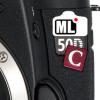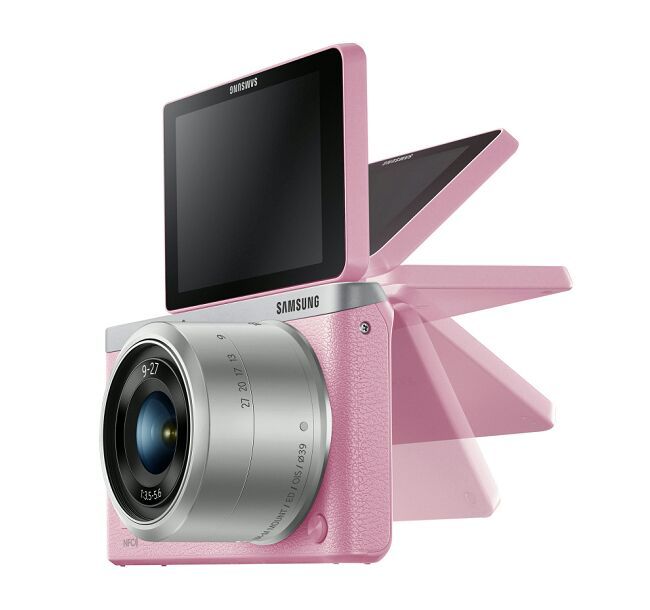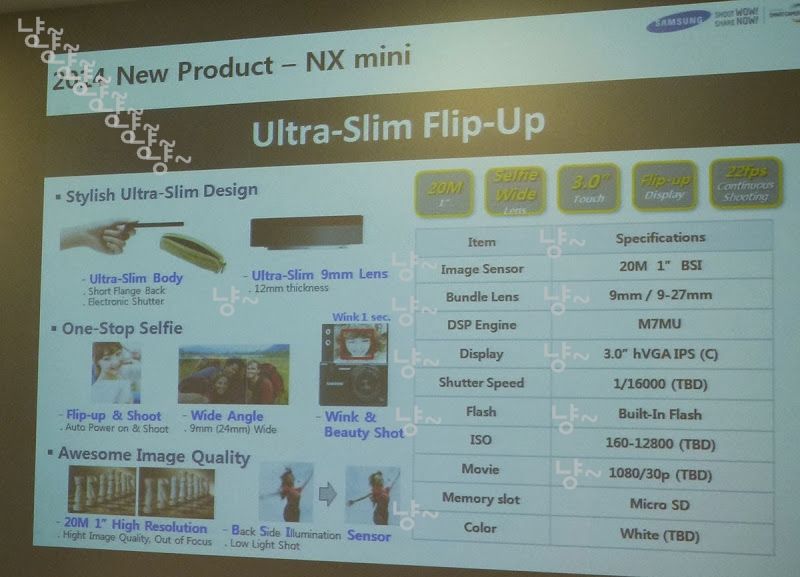-
Posts
1,653 -
Joined
-
Last visited
Content Type
Profiles
Forums
Articles
Posts posted by Julian
-
-
The >Press Release states that you can either use the 4K S35mm head or a 2/3-inch recording unit for 2K/1080p at up to 240 fps. I think that's a pretty nice feature. That makes it both a broadcast and production camera.
-
http://www.newsshooter.com/2014/02/27/welcome-back-to-the-game-panasonic/

I'm sure Andrew will do a proper write-up... but here is the Press release:
PANASONIC DEBUTS 4K CAMERA/RECORDER, VariCam 35, WITH NEW SUPER 35MM MOS SENSOR, AVC-ULTRA CODECS FOR 4K
Ultimate Image Production for Cinema and Episodic Drama; Breakthrough Modular Design Enables Docking Either 4K or 2/3-Inch Camera Head to Same Recording Module
NEWARK, NJ (February 27, 2014) – Panasonic today unveiled a 4K camera/recorder, VariCam® 35, that incorporates a newly-developed super 35mm MOS image sensor and the company’s AVC-ULTRA family of video codecs. The new camera’s superb image handling in multiple formats including 4K, UHD, 2K and HD make it an unparalleled tool for high-end filmmaking, and commercials and episodic production as well as live 4K events.
With its innovative design, the 4K camera module unit (AU-V35C1) is separate but dockable to the recording module unit (AU-VREC1), which is also interchangeable with Panasonic’s new 2/3†camera module unit (AU-V23HS1) (see separate news release). This system flexibility can be expanded with an umbilical cable between the s35mm 4K camera and the AVC-ULTRA recorder, providing “box†camera functionality for jibs, cranes and other “remote†camera needs. This common recorder module is also interchangeable with Panasonic’s new 2/3†1080p camera, enabling professionals to switch between s35mm and 2/3†camera heads to best suit their creative needs.
“Evoking the VariCam heritage of gorgeous, cinematic image rendition, this VariCam 35 establishes new standards for 4K production,†said Steve Cooperman, Product Manager, Panasonic System Communications Company of North America. “With its expanse of formats ranging from flawless 4K RAW output to more practical 4K, UHD, 2K and HD capture, the VariCam 35 represents a matchless option for premier digital capture.â€
The VariCam 35 utilizes a new Panasonic super 35mm MOS sensor for 4096 x 2160 (17:9) 4K image capture; this imager when combined with the AVC-ULTRA codecs for 4K enables very manageable and practical 4K production file sizes. The new imager boasts an impressive 14+ stops of latitude, and faithfully captures high-contrast, wide dynamic range imagery without compromise. Powerful color management capabilities provide a much extended color gamut for impeccable image fidelity, and permit support for an Academy Color Encoding System (ACES) workflow for full fidelity mastering of original source material.
Among the camera/recorder’s top-level production features are real-time, high frame rate, variable speed 4K recording up to 120fps, proving the capability for master level 2K/FHD recording; and advanced workflows with parallel simultaneous 4K/ UHD, reference 2K/HD and proxy recordings for in-camera on-set color grading and monitoring / editing ease. The camera also features a newly-developed OLED electronic viewfinder (EVF) with optical zoom functionality. Lastly, 24-bit LPCM audio is added for in-camera audio master recording.
The VariCam 35 will deliver an unprecedented breadth of recording formats, including 4K and UHD in AVC-ULTRA 4K, and 2K and FHD in AVC-Intra 100/200.* Addressing the need for high-speed file exchange, the camera encodes high-resolution proxy files in parallel with 4K and 2K production formats, enabling fast, efficient offline editing, at bit rates from 6 Mbps down to 1.5Mbps. Wireless workflows for proxy streaming and metadata management will also be available.
The VariCam 35 will use Panasonic’s new expressP2 card for high frame rate and 4K recording (see separate news release). The camera is equipped with a total of four memory card slots, two for expressP2 cards and two for microP2 cards. The new expressP2 card can record up to 130 minutes of 4K/24p content. The microP2 card is designed for recording HD or 2K at more typical production frame rates.
Professional interfaces include: 3G-HD-SDI x4 for 4K QUAD output; 3G-HD-SDI x2 for RAW output; an HD-SDI out for monitoring (down-converting from 4K); and two XLR inputs to record four channels of 24-bit, 48KHz audio. A multi-connector facilitates docking the camera head to the recording module. In another striking design innovation, the VariCam 35 boasts a removable control panel to facilitate real-time control and easy access when the camera is in a fixed position. The VariCam 35 features a standard 35mm PL mount.
The VariCam 35 will launch fall 2014, with pricing to be announced. For further information about Panasonic professional video products, visitwww.panasonic.com/broadcast.
*AVC-Intra200 is available only for FHD recording.
-
I haven't followed the topic, but I was curious if I could simulate the theory.
On Fred Miranda I found this topic that explains how Photoshop saves jpgs in 4:2:0 or 4:4:4
I used a full resolution JPG from the GH2 and took the following steps:
Cropped the image to 3840x2160 and saved as JPG quality 6. The result is a 4K 4:2:0 still.
Then I resized this image to 1920x1080 and saved it as quality 10 to make a 4:4:4 image.
I also resized the 4K 4:2:0 still to 1920x1080 and saved it at quality 6 to make a 1080p 4:2:0 image.
200% crops of the above images in same order:
4K 4:2:0
1080p 4:4:4
1080p 4:2:0
Not sure if this test is correct, but to me it looks like you can gain color resolution from downsampling the 4K 4:2:0 file to 1080p. Correct me if I'm wrong!
-
I'm just gonna go with a pick of my highest rated movies on my IMDB list:
- Blade Runner
- No Country for Old Men (surprised no one mentioned this, I love this movie)
- Old Boy (Oldeuboi) - original version of course
- Infernal Affairs (Mou Gaan dou)
- Exit Through the Gift Shop
- City of God (Cidade de Deus)
- The Matrix
- Carandiru
- Watchmen
- The Raid (Serbuan maut)
-
Different cameras do different things well. Notice the GoPro shot in that trailer?
I did, and the EOS 1D C too. I can imagine why the GoPro and 1DC are used because of the form factor, that's why I just mentioned the C500 and Alexa, both big cinema camera's.
BurnetRhoades answer makes sense though, the C500 for lowlight and the Alexa during the day. I didn't think of that.
-
Probably full res jpg (it has an electronical shutter anyway since it does 1/16000 of a second) but for how long, that is the question. Probably a second or so...
-
Sent you a message for the FlareFactory58!
-

http://www.mirrorlessrumors.com/first-pictures-of-the-samsung-nx-mini

Might have the Sony RX100(2) sensor
I want one! In pink.
If it's cheap and has somewhat decent video (24p/25p selectable) I'd be fun to use with C-mount lenses!
-
You promise only amazing video's... :-)
Who's gonna decide what is 'pro' or 'amazing'?
-
More info/pics here: http://www.superheadz.com/bellami/bellami.php
Anyone who can translate it?
/edit: used image to ocr and 'translated' it...
8mm camera Miako-me rare Bokuro.
The months `to, the Shotaima
丿 Rekamera evening Fu The - HD interchangeable lens type digital,
Be over over ami H D Ichi
Chinonka Hung `b 2 year §, 丶 ask three furnace Riko yaw this
Ako is fun months treasures assumed to use one 丿 Redorenzu Oh
Purodaku~tsu of heresy! -
Cool! Probably no competition for the Digital Bolex. I'm guessing it will have a standaard compact camera sensor, something like 1/2.3 inch, maybe 1/1.7 inch. Still looks like a fun camera if it's cheap.
-
Are you gonna watch all of the videos first?
-
It's not, the sensor in the D4/D4S isn't from Sony.
Just stop expecting every new dslr is going to be the next holy grail for video. This camera competes only with the Canon 1D X. And for video between the two, it does pretty ok I think.
Yes, I'd love Nikon to make a great video camera, especially since they have no Cinema division to 'protect', but it won't just happen out of the blue. At least not right now. -
Funny, although it's hard to see anything at all... Just makes me wonder, why would a DoP mix Canon C500 with Alexa, why not choose one system?
-
From the article:
The D4S has to compete with the Canon 1D X, a camera which has seemingly out performed the D4 on the market so far, which could help explain why Nikon have been unusually swift in updating the line.
Nothing unusual about this. The D4S was expected. Nikon has done this 'S' refresh after a few years since a long time. D2H < D2HS, D2X > D2XS, D3 > D3S... all pretty small updates. The D4 has been on the market for +2 years, so the S version was due...
-
-
-
Any cheap 135mm f/2.8 from the analogue era...
-
Anyone with a DSO Oval Aperture Helios and SLR Anamorphot here? I'd love to see some samples...
-
I thought the SLR Magic was ok with fast apertures...
-
3x zoom gives you the reach but it also changes the depth of field. The 24-70mm f/2.8 will virtually turn into a ~75-210 f/8.4. So you won't get the small DOF that is possible with the 70-200mm 2.8. If that's no problem, just go for the 24-70mm and decide from there if the crop mode works for you I'd say.
-
Nope. Bokeh!
-
Wide open samples please :) If you're shooting at f/4 the focal reducer doesn't really make sense imo. You could just use a 35mm...
-
Nice test. Looking like a good solution to get an easy anamorphic-like look. Sure as hell is easier to focus and handle than a dual focus setup.. Just don't like the corner performance, is that caused by the 0.7x adapter?
I don't think many people are using anamorphic for the resolution. It's all about the character of the lens.














I need a stabilised lens for the G6
In: Cameras
Posted
Yep. You'll have to go with Panasonic and they all have pretty small manual focus rings. Maybe use it with a follow focus?